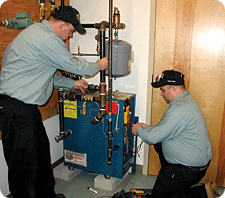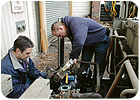
HVACR technicians like Sagamore Plumbing and Heating’s Brian Hathon (left) and Chris Lodge are making good money and receiving excellent benefits.
As the 2007 cooling season starts to emerge, HVACR contractors across the country are looking at their field staffing, hoping they will have enough quality coverage to make the season as profitable as possible.
Hiring good HVACR technicians is one thing; keeping them interested in staying with your company is another. A contractor can’t chain down a tech who is no longer interested in staying, and pay raises are only part of the solution. Professional growth, a good atmosphere, consideration, and respect are major factors that keep the best technical employees interested in sticking around.
Outstanding benefits are what keep outstanding field employees around, according to top HVACR contractors. Those perks go beyond medical and dental insurance, and even beyond short- and long-term disability. It can include eyeglass coverage, paid training, fitness incentives, paid vacations, and more.
Sagamore Plumbing and Heating, Weymouth, Mass., and Monsen Engineering Co., Fairfield, N.J., are representative of the top-tier commercial entrants inThe NEWS’annual “Best Contractor to Work For” contest.
Rod Rodrigues, Service Group manager for Sagamore, said that above all else, “the technician or mechanic has to feel that he is being taken care of. A technician or mechanic is an internal customer for the company.”
INSURANCE VS. WAGE
Rodrigues pointed out the importance of educating valued employees and prospective candidates on the difference between wage plus benefits, and straight wage. “You can have technicians leave you for 50 cents or a dollar more an hour, or they can go for a better family benefit,” he said.“A lot of guys are looking at the benefits because the cost of health care is crazy. A lot of guys are weighing pay per hour versus benefits,” he continued. “The benefit package is huge, even for the younger guys now.”
Rodrigues recently calculated that on average, the benefits per Sagamore employee average out to $20,000 per year. “They’re not aware of everything that goes into it until they see it broken out on a form,” he said. “All they think of is base pay. Some of my lead guys are already at $100,000 per year in total pay and benefits.” The contractor makes sure they know it.
Carrie Grotz, an administrative assistant in the service department for Monsen, said the technical and field employees’ core benefits are negotiated through the union. Still, the company offers other work-related perks, such as cell phones and PDAs for those employees who need them.
“Our goal is to start using Mobile Tech systems, including laptops they can take out with them,” she said. “They can access the history of work we’ve done for that customer, right there at their fingertips.” Trucks are equipped with GPS. The company also is working on implementing a paperless, wireless dispatch system.

Kevin Francis and John Falco, two Monsen Engineering technicians, are shown working on a compressor replacement at Marcal Paper Products. The employees appreciate the contractor’s “free and open dialog, without fear of retribution.”
THIRST FOR KNOWLEDGE
Paid training is another key benefit that techs appreciate - enough to make them want to stay with a company.“A lot of guys will come to work here because they have the ability to go to school for free,” said Rodrigues. “He has to feel that he’s coming out ahead. When you recruit somebody, you need to have the benefits or incentives in place.”
Sagamore’s training facility has been approved by the Massachusetts State Board of Examiners of Plumbers & Gasfitters, the Massachusetts Department of Public Safety, and has been recognized and approved by the Massachusetts Department of Labor and Workforce Division of Apprentice Training. The center has also received accreditation from the National Center for Construction Education and Research (NCCER).
The company holds classes for apprentice, OSHA safety, medical gas handling, crew leadership development, and blueprint reading training, plus product demos.
“I believe the training that’s offered keeps our people around,” said Grotz. “Right now our big effort is offering UA-STAR training. There is a 10-week review program that they attend one night a week.” In addition to dinner that night, attendees get the training, manuals, “everything they need,” Grotz said. Passing the test then leads to increased benefits and compensation for the techs because it offers more opportunities for the company when it can say its employees are UA-STAR certified.
The company also has LEED-certified engineers, and NEBB- and NATE-certified technicians. Sagamore has invested more than $200,000 in its own automated training facility; the company has a full-time NCCER-certified and OSHA-certified instructor. Its plumbing and pipefitting apprentice training program is state-certified, privately held and funded. Like Monsen’s training, classes are only open to Sagamore employees.
The owners pay for tuition, books, and materials for all enrolled apprentices, Rodrigues said. “This equates to approximately $1,000 per year for each enrolled apprentice. There is also a company-funded, $2,000-a-year, trade-specific educational reimbursement benefit,” dependent upon the employee getting a passing grade.
Employees are required to go through an OSHA construction safety and health 30-hour course, American Red Cross CPR, and first aid classes. These are given at Sagamore and are funded by the company. All employees recertify in CPR, first aid, and OSHA 30 requirements annually, at no cost to the employee, Rodrigues said. New hires also must complete driver certification classes.

Keeping a finger on the pulse of employee understanding of company benefits, like 401(k) programs, helps Sagamore Plumbing and Heating prevent misunderstandings that could lead to dissatisfaction. Here, Taze Picard (left) explains financial savings benefits to Brian Campbell, both client sales associates.
WELL ABOVE AVERAGE
It makes sense that in order to attract and retain really outstanding technicians, contractors like Monsen and Sagamore go out of their way to provide really outstanding benefits, opportunities, and atmosphere. “I think it’s a very friendly atmosphere,” said Grotz. “It’s not like everybody’s hovering over you all the time. We do a good job and get our work done.”The company’s Safety Jackpot encourages employees to work safely by awarding prizes for safe work habits. It includes a yearly drawing for $10,000, a prize catalog, and more. “Safety information is sent out weekly with paychecks, plus a Safety Jackpot card,” Grotz explained. “Each card contains points, which can be collected to earn prizes from a catalog.” Each card also contains a letter; collecting all the letters to spell “jackpot” allows the employee to enter the big drawing. Technician Mike Paserchia won $750 from a safety drawing for being accident-free.
“Besides all the perks and benefits,” Grotz added, “the company also sends a fruit and candy basket to each employee’s home for milestone birthdays; Pottery Barn baby blankets to families with newborns; and gift certificates to employees who were recently married.” Employment anniversaries are acknowledged with prepaid gift cards.
Sagamore speaks directly to top technicians’ hearts when its Website states, “By becoming an employee you would be joining a company with a fine reputation for service, quality workmanship, and dedication to the industry.”
The company’s benefit program includes a college savings plan, and health club and Weight Watchers® program discounts. Safety incentive programs and contests help keep employees safety conscious.
“They’re doing a lot of things right,” said Rodrigues. “In the eight months I’ve been here, we’ve determined true break-even of service pricing and created a pricing book for HVAC and plumbing. We stripped the existing service trucks and brought in new racking systems.
“A lot of parents say, ‘I don’t want my son to grow up to be a plumber or air conditioning repairman.’ They don’t respect the industry,” Rodrigues said. “But I’ve had a couple of service guys making $80,000 a year.
“I’ve seen a lot of people leave jobs more for benefits than for pay,” he continued. Also, some environments are tougher than others. When you push your technicians really hard, you will lose them eventually.
“You’ve got to talk to these employees and find out what motivates them,” he said. For instance, when Sagamore surveyed its office and field personnel (its internal customers), the company learned that some employees weren’t comfortable with the 401(k). The company answered by holding sessions to explain about what the 401(k) program is, and what it means to these employees’ futures.
Maybe no one would have left because they didn’t understand their 401(k), but it could have been the base upon which other problems could grow. “A lot of people will have an issue and you never find out until they’re leaving,” Rodrigues said.
Publication date:04/02/2007

Report Abusive Comment